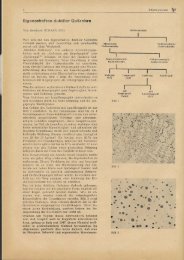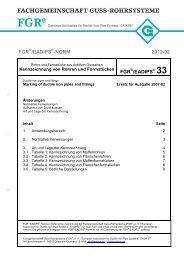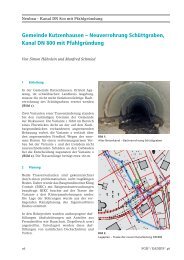Download PDF file
Download PDF file
Download PDF file
- TAGS
- download
- 81.169.135.155
Create successful ePaper yourself
Turn your PDF publications into a flip-book with our unique Google optimized e-Paper software.
What is more, ductile iron pipes have a guarantee<br />
of hygienic and environmentally friendly<br />
operation in the form of their linings (polyurethane<br />
to EN 15655 [6] and mortar based on<br />
blast furnace cement for the supply of drinking<br />
water [7] or mortar based on high-alumina<br />
cement for the disposal of sewage [8]).<br />
4 Durability:<br />
Avoidance of future expenditure<br />
There is no other pipe material which can provide<br />
such convincing practical proof of its<br />
durability, and therefore of the safety which it<br />
maintains for generations, as ductile iron. The<br />
technical operating life of ductile iron pipes is<br />
up to 140 years. If ductile iron pipes with their<br />
high-grade coatings as follows<br />
■ a cement mortar coating (ZM-U) to EN<br />
15542 [9] and<br />
■ polyurethane (PUR) to EN 15189 [10]<br />
are taken as a basis, they provide a particularly<br />
impressive and emphatic confirmation of<br />
this long operating life. A systematic study has<br />
been made in which the outer surfaces of pipes<br />
which had been in operation for periods of up to<br />
32 years were examined and samples for examination<br />
under DIN 50929, part 3 [11] were taken<br />
of the native soils and of the bedding materials<br />
used in the respective cases. At all the test digs,<br />
it was found that, after being in use for from<br />
25 to 32 years, pipes coated with cement mortar<br />
were in a virtually good as new state and were<br />
not showing any damage due to corrosion [12].<br />
Similar studies to provide practical proof of the<br />
long-term resistance of the polyurethane coating<br />
are going on in Switzerland. Two runs of<br />
test pipeline, which are continuously monitored<br />
by the SGK (Swiss Society for Corrosion<br />
Protection), have been operating for more than<br />
20 years in Zurich. The protective potentials of<br />
the polyurethane coated pipes and their contact<br />
resistances with the ground are measured in<br />
different soils. In all the beddings studied, these<br />
field studies show constant good performance<br />
on the part of ductile iron pipes coated with<br />
polyurethane [13].<br />
From all these studies, it can be concluded<br />
that these ductile iron pipe systems with<br />
high-grade coatings, will undoubtedly<br />
achieve a technical operating life of 100 to<br />
140 years.<br />
10<br />
A glance at the pre-industrial era reveals<br />
another impressive fact: In 1783, Clemens<br />
Wenceslaus, the Archbishop-Elector of Trier,<br />
gave instructions for a water pipeline to be<br />
laid to supply the public wells of the town of<br />
Koblenz. This pipeline, known as the Metternich<br />
water pipeline, consisted of socketed cast<br />
iron pipes of a laying length of 1.5 metres and<br />
a diameter of 80 millimetres. When, after more<br />
than 150 years, this pipeline was exposed in<br />
1934, it was found that the material of the<br />
pipes was still in excellent condition after their<br />
long time in operation. The then Lord Mayor<br />
of Koblenz confirmed this in an official letter<br />
to the “Deutscher Gußrohr-Verband” [14],<br />
today’s europäische Fachgemeinschaft Guss-<br />
Rohr systeme (FGR®) e. V. / European Association<br />
for Ductile Iron Pipe Systems · EADIPS®,<br />
www. eadips.org.<br />
Polyethylene pipes are assumed to have an<br />
operating life of around 60 years. That is less<br />
than half the demonstrable working life of ductile<br />
iron pipes. This means that re-investment<br />
and rehabilitation budgets can be set at an<br />
appreciably lower level when ductile iron pipes<br />
are used.<br />
5 Trenchless installation techniques and pipelines<br />
subject to high stresses<br />
Trenchless installation techniques have now<br />
become very important all over Europe. To avoid<br />
site noise and obstacles to traffic in inner-city<br />
areas and to allow crossings to be made under<br />
obstructions such as roads or rivers, trenchless<br />
installation techniques are now indispensable<br />
when pressure pipelines have to be replaced.<br />
They are low-cost techniques which are kind<br />
to the environment. There was been a close<br />
connection between their development and<br />
the ductile iron pipe and its joints and types of<br />
external protection. Because of their ability to<br />
carry high mechanical loads, ductile iron pipes<br />
with restrained joints are very much superior to<br />
pipes of any other material for trenchless installation<br />
(Fig. 3), a superiority which is also seen<br />
in the allowable tractive forces which can be<br />
used with them (Fig. 4).<br />
FGR® / EADIPS® 46
















